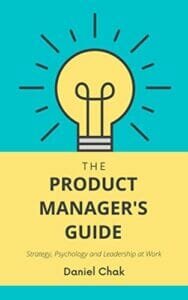In this adapted chapter from his book The Product Manager's Guide: Strategy, Psychology and Leadership at Work, Daniel Chak, Managing Director at JPMorgan Chase & Co. discusses the fundamentals of product management for those aspiring to break into the product management craft, or those who need a refresher and are looking to go back to basics.
No one really knows how the game is played
The art of the trade
How the sausage gets made
We just assume that it happens
But no one else is in
The room where it happens.
No one really knows how the
Parties get to yes
The pieces that are sacrificed in
Ev’ry game of chess
We just assume that it happens
But no one else is in
The room where it happens.
I wanna be
In the room where it happens.
Oh, I’ve got to be in
The room where it happens.
— Aaron Burr, Hamilton the Musical
I cannot count the number of times people have told me, “You have my dream job!” The product manager job is highly coveted. I’m grateful to have been a Product Manager at Google for more than eight years, where I gained the experience that I put into this book.
Why do so many people — even those who already have great jobs in other roles at Google — want to become product managers? What is so special about this job?
The product manager is at the center of the work that goes into creating the tech products millions of people rely on and enjoy using every single day. They’re responsible for the strategy, for the trade-offs that are considered and the decisions that are ultimately made. As such, they are always in the room where it happens, and as the lyrics from Hamilton say, that’s where a lot of people want to be.
Product management is, in my humble opinion, the most exciting role in any company. It’s also a role with a lot of responsibility. In exchange for being in the room and owning decisions, the product manager is also responsible for the outcomes and the consequences. Sometimes the outcomes are good and sometimes they are not so good. Watch this #mtpcon Digital Americas keynote where Bruce MaCarthy analyses product outcomes.
For some people, having this responsibility and the potential for failure can be a heavy burden. But for those who are energized by risk, who are comfortable not knowing all the answers ahead of time, and who are skilled in driving clarity where there has only been ambiguity, a career in product management can be just what the doctor ordered.
What is product management?
One day, I was having lunch with one of my engineering teams at Google. I hadn’t been working with them for very long yet, but I’d helped them come up with a new roadmap and prioritize their work for the next couple quarters. I believed the team now had a clear line of sight to how and when they would launch important features to users, and I was feeling pretty happy about my contributions. Surely they were happy with my contributions, too, right? During a lull in the lunchtime conversation, one of the engineers looked at me and asked out of the blue, “Dan, what do you do, anyway? I mean, what does a product manager do?”
Truly, the entire job description can be difficult to describe in a single sentence. The product manager is measured by their ability to mobilize the company to launch products, and then by the success or failure of those products.
At the highest level, the product managers’ main responsibility is to make sure the team is working on the right things. The product manager builds a clear vision for the product direction, then gets everyone on board that it’s the right thing to do, and then supports the team in delivering on the vision.
Product Management is a unique leveraged role. The result of a product manager doing their work is that work is created for others – months or years of work. Not just busywork, but valuable and meaningful work that is aligned to the company’s mission, fulfills a vision, and achieves business goals. From conception through launch and maintenance of a product, the product manager ensures the entire team’s work is aligned with purposeful goals and that the team’s efforts produce business outcomes.
Always working collaboratively with others, the product manager guides the team through the entire product development life cycle.
First understand customer or user needs, aligning on goals and objectives, developing a strategy, and communicating a rough picture of what the product will do, and for whom. Watch this keynote session at #mtpcon SF+Americas 2022 where Dan Olsen discusses prioritising customer needs.
Then, define the product more concretely so it can actually be built by an engineering team. Next, support the engineering team while the product is built, all the while working with other teams like marketing, legal, customer support, and other teams to prepare for the product launch.
A product manager’s work ultimately results in product launches. But even after a launch, the work is not done. They’re measured not only by launches but by outcomes. The product manager continues to work with the team to tune the product and iterate on the features as needed to achieve the vision.
All along the way, the product manager authors a series of documents: stakeholders-facing documents that communicate vision, strategy, and high-level plans; team-facing documents that define product behavior, and any other documentation needed to fully specify the product and the decisions that went into its design. These tangible artifacts point the way for the team throughout product development, and in the end are the remaining traces left behind that reveal the product manager’s contribution as a supportive but decisive guiding hand in the organization.
Let’s break that down a bit.
Understand customer or user needs
The product manager needs to understand the market and their user. In an enterprise product, there are often a small number of large customers who have very specific needs and you can bring them into a design process to solve those needs well. In a consumer product with millions to billions of users, you need tools to uncover general problems and ensure that customers at large identify with the problem you're solving, and understand and react well to your solution. Read Building for Billions in India: Meeting the Challenge of Building Products For A Complex Country.
Build a clear vision
With an understanding of the market and their user, and with business goals in mind, the product manager works with the team to develop a vision for the product. What does the product need to do to solve the customer problem and achieve the business goals? And what needs to be done to get the product from where it is now to where it needs to be?
Get everyone on board
The product manager needs to get everyone on board with the vision. They are their product’s spokesperson, cheerleader and chief negotiator. But they also need to be humble and collaborative; the plan the team is most likely to accept is the one they helped to craft themselves. The product manager should be open to adapting the vision to incorporate the team’s collective wisdom to get buy-in.
Structure the work
The product manager drives the end-to-end process of turning a vision into reality. The next steps are to translate the vision into concrete, clear goals and measurable objectives; a strategy to achieve the goals; and a concrete description for the product to be built. The product manager supports the team in execution – the actual building of the product and anything else required to launch it – by developing project plans, helping the team work through issues as they arise, and clearing organizational challenges that might otherwise slow the team down.
Help the team realize the vision
The product manager succeeds only when their team succeeds in delivering a great product that performs well in the market.
There are a lot of external reasons a product launch might fail to launch at all; for example: misunderstanding the user needs, building the wrong product to address the needs; and incorrect pricing, targeting, or market timing. There are also many internal reasons a product might fail to launch; for example problems with team function and morale, internal politics, shifting priorities or lack of resources.
The product manager leads the cross-functional team to take advantage of the product opportunity. Meanwhile, they need to keep the team motivated while maintaining wellbeing; securing stakeholder buy-in; and negotiating for resources that the team needs to deliver. What a job!
Are you interested in becoming a product manager – or if you already have that title, are you interested in leveling up your skills? My book, The Product Manager’s Guide, strives to help Product Managers see the structure in their job so they can be successful sooner. When you know what’s coming next, you can be thoughtful about how you approach the job and be deliberate rather than reactive. When you know all the people in your company who have a role to play in the full product life cycle, you can get the product out the door smoothly. When you have tips in your back pocket, you’ll be most effective.
I wish you well in your product journey!








